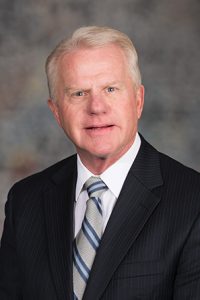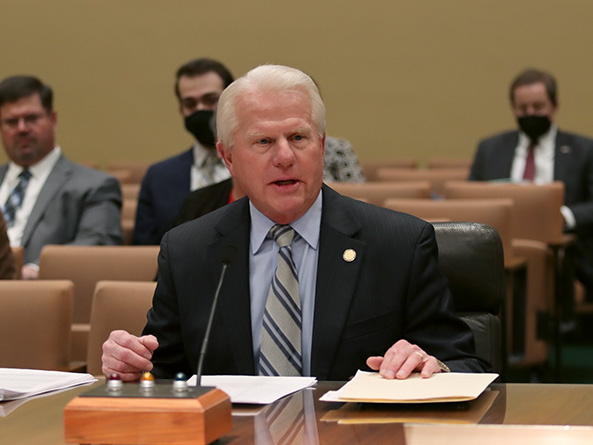Array of university funding proposals considered
The Appropriations Committee heard several proposals Feb. 17 that would use federal pandemic relief dollars to fund a variety of University of Nebraska projects. The state has been allocated $1.4 billion in American Rescue Plan Act funds.

Ted Carter, president of the University of Nebraska system, testified in support of all the proposals. He said the university grows Nebraska’s economy by $5.8 billion a year and strategic investment of ARPA funds would allow the state to focus on areas where the university already is strong and has attracted some of the best talent in the world.
“These one-time federal funds offer our state a rare opportunity not only to recover from the pandemic, but to grow our economy and quality of life for generations to come,” Carter said.
LB703, sponsored by Gothenburg Sen. Matt Williams, would appropriate $25 million in ARPA funds toward construction of an agricultural innovation facility at the University of Nebraska Innovation Campus in Lincoln. The bill would require $25 million in matching funds from private sources.
Williams said the facility would be a companion to the National Center for Resilient and Regenerative Agriculture, a $140 million facility proposed by the US Department of Agriculture that also would be located at Innovation Campus. The USDA center would provide “cutting edge” research to help Nebraska producers boost their yields, manage drought and improve animal health, he said.
“The kind of research we’re talking about isn’t ivory tower activity with meager relevance to practical agriculture,” Williams said. “The USDA researchers, along with direct participation by dozens of UNL faculty members, will be expanding scientific knowledge with the utmost real world utility to farmers and ranchers.”
Lisa Lunz, a Dixon County farmer, testified in support of the bill. LB703 could help farmers produce more food with fewer resources, she said, by bridging the gap between research and actual farming practices. Lunz said precision agriculture tools have allowed her and her husband to produce greater yields of corn and soybeans with fewer inputs.
“We need research and technology to take advantage of the limited resources we have,” she said. “Agriculture needs to … attract the best students to help grow the workforce and turn innovation into tools that farmers and ranchers can use to improve their safety, profitability, efficiency and resiliency.”
Burlington Capital Investment president Michael Jung also testified in favor. Jung said his company, which develops agricultural technology, is often told that innovations developed outside the Midwest aren’t the right fit for Nebraska producers. Local innovation could help solve that problem, he said.
“[LB703] will allow for Nebraska to become a leader in developing, attracting and retaining … ag-minded entrepreneurs, engineers, startups and innovative thinkers,” Jung said.
Also considered was LB721, sponsored by Omaha Sen. Robert Hilkemann, which would appropriate $60 million in ARPA funds for a facility at the University of Nebraska Medical Center Rural Health Complex on the University of Nebraska at Kearney campus. The proposal would require $60 million in private matching funds.
Hilkemann said the ability to train health care workers in rural areas would help strengthen and maintain community ties. The center would create new programming in allied health professions, medicine, nursing, pharmacy and public health, he said.
“Ensuring [an] adequate health care workforce for rural communities has been a long-standing challenge for Nebraska,” he said. “The pandemic has accentuated this challenge and the need for definitive action.”
Doug Kristensen, chancellor of the University of Nebraska at Kearney, testified in support of the proposal. Fourteen of the state’s 93 counties lack a primary care physician, he said, yet Nebraska currently lacks the capacity to train those needed providers.
“If you provide students comprehensive, quality education in rural Nebraska, they will stay in rural Nebraska,” Kristensen said. “LB721 is not just a building, it’s a chance to deliver to Nebraska the high-quality rural health care it so desperately needs.”
The committee also considered the following ARPA appropriations to the university:
• $50 million to establish the Artificial Intelligence, Cybersecurity and Holland Computer Center at Innovation Campus under LB904, sponsored by Adams Sen. Myron Dorn;
• $15 million for pancreatic cancer research under LB766, sponsored by Seward Sen. Mark Kolterman;
• $10 million to the Global Center for Health Security at the University of Nebraska Medical Center under LB950, sponsored by Bennington Sen. Wendy DeBoer;
• $4 million for the Global Center for Health Security at the University of Nebraska at Omaha, under LB961, sponsored by Omaha Sen. Tony Vargas;
• $5 million to construct a Science, Technology, Engineering & Mathematics (STEM) Trail Center at UNO under LB962, also sponsored by Vargas; and
• $16 million to modernize academic research laboratories and equipment at the UNO College of Education, Health and Human Sciences to support work in the Department of Biomechanics and for the Health and Kinesiology Research, Engagement and Community Hub initiative under LB1054, sponsored by Omaha Sen. Mike McDonnell.
No one testified in opposition to any of the bills and the committee took no immediate action.


